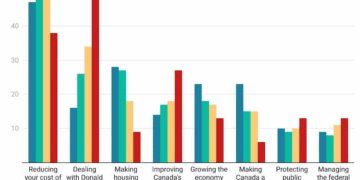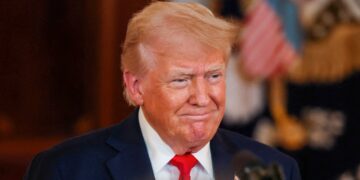99.32% over the 44 years since it opened up China has become the world’s second largest economy by nominal GDP and has even surpassed the United States when measured in GDP by purchasing power parity inure signs of it economic strength China managed to avoid recession during both the global
Financial crisis of 2008 and the covid-19 pandemic of 2020 to 2021 however since 2010 when it surpassed Japan to become the world’s second largest economy the trend has been clear China’s rate of economic growth is slowing down the country grew by only 2.99% in 2022 which is low by its
Standards what is going on in China’s economy and what does it mean for that Country and the security of the indopacific region since the internal chaos in China ended with Mao’s death the Chinese Communist party has maintained power on an implicit promise it would still rule in an authoritarian
Manner but in exchange the people would get the benefit of security and fast economic growth so far the party has managed to fulfill This Promise made in China has practically become an institution in the global economy the People’s Republic has entrenched itself at the heart of the world’s supply chain
And not just in cheap manufactured goods either China dominates the manufacturing process of many of the world’s most important Supply chains for example it holds a near Monopoly position in The Rare Earth elements that are crucial Ro components for the modern digital economy China controls 50 to 60% of the
Mining market for these materials and 90% of the intermediate processing stage China’s GDP per capita has risen from $16.4 in 1978 to 12,000 $720 in 2022 however this period of Breakneck unprecedented economic growth came with hidden costs and those cracks in the foundation are now beginning to show one
Of the most important of these problems is China’s looming demographic plunge long the world’s most populous country China peaked in population in about 2020 and has now begun a slow decline un sources estimate that India surpassed it as the world’s most highly populated country in April 2023 by the end of the
Century demographers predict that China will have about 776 million people a little over half of what it has today this is bad enough for the Chinese economy but hidden beneath these raw numbers are trends that are arguably worse China’s working population peaked at about 7635 million in 2014 in 2022 it had
Shrunk to 733.702 population could shrink by over 10% meanwhile the elderly are growing as a share of the Chinese population and it is happening at a rapid rate in 2015 there were 136.6 million people over the age of 65 in China which is more than Japan’s entire population and the trend will
Accelerate by 2030 China’s 65 and over population will be 238.5 million more than Japan and Egypt combined total populations by 2050 China’s elderly will be almost 350 million strong equal to the total combined populations of Japan Egypt Australia and Germany there is also a comparative lack of younger people in
China to support these aging people compared to that seen in other countries this problem comes as a result of China’s one child policy which was implemented Between 1979 and 2015 as a way to curb the supposed problem of overpopulation although the policy was modified to two children in 20 2015 and
All limits on child birth were removed in 2021 the consequences of this policy will be felt for many years to come for nearly 40 years the one child policy limited the growth of the younger cohorts of China’s population the Chinese government has been trying to encourage women to have more children
But in this it’s facing another hurdle the one child policy created for so long China has a serious shortage of women of childbearing age Chinese families have long had cultural preferences for sons over daughters the inability for families to have more than one child meant that female fetuses were
Preferentially aborted during the years the one child policy was in place infanticide and abandonment of daughters were also widespread in certain areas one 2015 study found that in some areas where it was common as many as one in 10 baby girls were abandoned in the 1990s lucky abandoned girls were adopted by
Families abroad others faced social disadvantages in their adopted family homes unlucky ones did not survive another 2015 study estimated that there were 62 million missing women in China women who would be alive today if not for the one child policy and the preference for male births because of the combination of these cultural
Practices and the Draconian one child policy millions of Chinese men cannot find wives in 2021 there were about 30 million more men than women in China and the Gap is widening perhaps unsurprisingly China’s fertility rate has fallen to a historic low of 1.23 births per woman the easing and eventual
Overturning of the one child policy has not been enough to stop this trend child rearing is also expensive as raising one child to the age of 18 costs nearly seven times China’s GDP per capita and China’s Draconian response to the covid-19 pandemic ensured that even expecting mothers had limited Hospital
Access further disincentivizing women from having children why are these demographic issues so problematic for China going forward because the country has long relied on a young and mobile Workforce productivity will therefore decrease as this cohort become less of a presence in the overall population the shortage of workers especially in the
Country’s all important manufacturing sector will lead to increased wages and reduced profitability for the companies involved making China less of an attractive place to invest as India’s population grows and remains younger than China companies will likely see it as a more attractive place to allocate Capital 2 as its Workforce proportion
Will increase in population relative to China meanwhile China’s response to the covid-19 pandemic its Draconian zero covid policy with frequent lockdowns that lasted from January 2020 to December 2022 has done more than harm expecting mothers it’s disrupted China’s Supply chains further increasing the incentive for foreign investors to park
Their manufacturing elsewhere to make matters worse China’s population is aging at an earlier stage of the country’s National development than that’s seen in places like Japan or Europe China will therefore need to adjust how it cares for its elderly this is expensive and will require institutional changes particularly as
There are fewer younger working people to care for their elderly relatives which has been the cultural norm in China up until now without institutional support the growing cost of Elder Care will even further disincentivize young people from having children making for an even worse demographic problem in the
Future China may need to look at it neighbor Japan for a model on how to take care of an increasingly elderly population however China’s economy faces shorter term challenges as well one of the nagging problems is that its Belton Road initiative BR which was one of the centerpieces announcing China’s arrival
As a supposed Global Financial Powerhouse is rapidly becoming a trillion doll disaster in 2013 China began the brri as a means to expand its influence by investing in the infrastructure of So Many Nations on the Eurasian landmass and the the African continent China could reorient World Commerce away from the United States and
Toward routes that Converge on Beijing routs conveniently harder for the American Military to reach however these Investments have not been able to deliver on the Ambitions Beijing had for them examples of less than optimal results abound from Kenya’s railroad to Nowhere to the financial failure of Sri Lanka’s hambantota port to the scaling
Back of the China Pakistan economic Corridor CP originally worth $62 billion CP has been subject to corruption Financial setbacks and terrorist attacks the Project’s Crown Jewel the port of guad on the Indian Ocean did not meet the financial expectations that China or Pakistan believed that improvements to
The port would afford it the lack of performance of CP has swelled Pakistan’s national debt and forced the country to take a $6.3 billion bailout from the IMF in fact China’s Financial practices for its BR have set the ambitious scheme up for failure while infrastructure investments from Western countries typically have low
Interest rates over 30-year periods China’s BR can have interest rates as high as 7% for half that time span China also imposes coercive terms in lending the money it can call in debts at any time and often prohibits the deta countries from getting refinancing or being able to restructure their payments
These terms have now had some unexpected consequences for the Creditor country firstly the BR is not meeting its expectations and the costs involved to the deta countries have prompted participants to leave Italy and the Philippines were two of the most important countries to join the brri as China’s gaining influence within them
Could have given it some leverage over the us-led alliance system however both of them pulled out of the brri in 2023 as BR related projects have often not delivered on their promises more countries are reassessing or leaving China’s infrastructure program meanwhile as the countries that have taken Chinese
Money often have trouble paying back the funds those outstanding debts have become a problem for the Creditor country China’s brri began with a lending spree on terms that seemed lopsided in beijing’s favor unfortunately for Beijing when the Creditor lends $1 trillion that creditor is placing itself in a position of
Vulnerability by lending so much under such harsh conditions to less than creditworthy customers and projects China was taking as big of a gamble as the deta countries the numbers bear this out in 2010 only 5% of China’s overseas lending portfolio went to parties that were in financial distress in 2023 that
Number is 60% the end result is that Beijing now has a major problem on its hands in getting the money back China has needed to issue 240 billion in emergency loans to 22 countries 80% of those loans came between 2016 and 21 however those bailouts didn’t come cheaply the deta countries needed to
Take a 5% interest rate over twice that charged by the IMF under similar circumstances this Dynamic raises longer term questions about the sustainability of Chinese brri debt and whether China will ever get its money back the Bri is also slowing down as countries grow more worried about China’s International
Ambitions especially in the wake of the covid-19 pandemic they have been more concerned about the security risks of the brri and hesitant to start new projects under its Banner although secondary to the worries over security risks environmental concerns have also been increasing in relation to the BR causing additional hesitance China has
Attempted to address the environmental concerns in 2019 the leadership in Beijing pledged to reformat the brri into an open clean and green project however there is little indication that environmental contingencies are taking place in existing BR projects and China’s response to the covid-19 pandemic and its wolf Warrior diplomacy
Have further increased skepticism of beijing’s initiative abroad the United States is also making it more difficult for China to implement the BR America’s sanctions on Chinese state-owned firms many of which have been heavily involved in the BR increase the hesitance of thirdparty organizations to work with them for example China has already asked
For collaborations with third parties in the marketplace to reduce the costs of financing the brri attempting to collaborate with France Italy and Singapore in the process however because of American sanctions on Chinese companies involved in the brri these third parties that China is attempting to bring on board are more hesitant to
Offer assistance leaving China on the hook and hoping it gets its money back China’s brri is therefore facing problems which now threaten to undermine the homeland’s economy and contribute to China’s own considerable financial problems as China grew so rapidly it went on a lending spree at home just as
Much as it did with the brri abroad The Lending spree is now creating problems in the the Chinese domestic economy one of these is in the growing debt problems faced by municipalities in China for example Wuhan the largest city in central China and the origin of the covid-19 pandemic has been forced to
Call in the loans it extended to hundreds of local entities according to the city’s Finance Bureau 259 entities owe it a combined total equivalent to $14 million these organizations include public and private companies government departments and even think tanks another consequence of China’s zero covid policy was to drain the budget of many
Municipal and provincial governments adding to the provincial and Municipal debt problems the lockdowns prevented economic activity while governments were forced to spend large amounts of money on frequent Mass testing programs and quarantine centers to further illustrate the problem guandong Province alone spent $22 billion on the Zero covid policy while revenues declined sharply
Tax breaks to businesses hit hard by China’s zero covid policy have also contributed to declining revenues and reduced local government services over $524 billion worth of such tax breaks were granted by government entities across China in total China could have outstanding government debt over $188 trillion $1 trillion of which is hidden
Debt the riskier local government financing agents owe some of China’s cities have responded by reducing medical spending for the country’s growing elderly population cutting transportation services and lowering fuel subsidies Chinese municipalities have also been forced to reduce wages paid to government employees even wealthier provinces like guandong Z Jang
And jangu have forced their workforces to take 30% pay cuts overall in the span between 2016 and 2023 China’s government debt Grew From A 47% ratio of its GDP to 102% this ratio is still behind the United States at 122% of GDP but the the debt growth rate in China has been far
Steeper China’s real estate problems are adding to the problems of government debt and economic weakness land sales make up about 40% of the revenues for local governments in China unfortunately for them these have been in Decline after a long period of expansion between January and October 2022 land sales in
China fell by 26% from the same Span in 2021 China’s real estate developers are losing Revenue as well due to collapsing home sales data released by China’s 100 biggest property developers show that new home sales were 33% lower in July 2023 than they were a year earlier China’s largest property developer
Country Garden abruptly withdrew from an attempt to raise $300 million in new shares on the news of the decline in home sales in October 2023 International observers believed that Country Garden had defaulted on its foreign debt payments international bond holders were reported in Reuters as seeking urg talks with the company Country Gardens
Troubles are far from an isolated case in 2021 China saw a wave of defaults by Major property developers evergrand another of China’s Behemoth real estate developers was declared to be in default in December of that year failing to make $82.5 billion worth of interest payments everr has since gone into bankruptcy the
Everr problems accompanied those of kaiza another property developer which had its shares halted on the Hong Kong Stock Exchange after it became unlikely to meet a $400 million offshore debt deadline China’s real estate market was critical to its rise as an economic Powerhouse making up as much as 30% of
Its GDP overexpansion of the property Market however has long L investors and foreign observers to point out a bubble in the real estate sector China’s ghost cities have become a frequent item of international attention there maybe be as many as 50 of these cities at various stages of development originally these
Were intended to redistribute some economic opportunities and give rural people somewhere else to go than China’s huge coastal cities however these developments have often not delivered on their promises to investors there may be as many as 50 million empty apartments in these developments which have few or
No residents in total which means they are not returning the capital that was spent in creating them Chinese authorities have tried to shore up the property market and have at times demonstrated the ability to develop cities from scratch the Peong District in Shanghai was once a swamp today it
Has a population of about 5.6 million the ingredients for success in the top- down developmental approach are availability of jobs and transportation but it’s far from certain if China will be able to translate the success of Peong to the other ghost cities located further away from China’s Coastal Heartland China’s demographic problems
Will also present an increasing challenge to the unused property that attracted so much Capital during the expansion phase less people means less demand for the large L amounts of homes and shopping centers that China has accumulated over the years China’s economy has also become less productive because of its increasing politicization
The frequent embedding of Communist party members in private companies and the authorities favoring state-owned companies over private ones has made domestic investors nervous and foreign investors even more leery about putting their money into Chinese Enterprises China’s ability to keep itself at the center of existing Supply chains and
Entrench itself at the center of future Supply chains will be put further into question China has become a Colossus in the global economy but some of the measures it took over the years to ensure its continued growth increasingly look like they have proven shortsighted with aversion from International investors sanctions from the United
States and fewer people to make purchases in real property or in consumer goods China’s economic growth will continue to slow down and with uncertain debt structures both at home and abroad a Chinese financial crisis seems inevitable meanwhile China’s increasing economic weakness could pose even more security challenges in the
Indo Pacific region China has invested much of its wealth into its military buildup and with economic troubles growing Beijing might get the impression that it needs to use its military power to remake the order in the region now when it still has the chance and the inertia from its period of economic
Growth is still going this is why many American military leaders and National Security Experts worry about an invasion of Taiwan before 2030 the situation with the growing Regional power close to peaking in its influence resembles that scene in Germany before World War I but do you think the same what do you think
Are some of the challenges facing the Chinese economy as we move into the second quarter of the 21st century will China’s economic problems add to a short-term security challenge for the Indo Pacific region don’t forget to let us know in the comments make sure to hit the like And subscribe buttons to
Support the channel and get more military analysis from military experts that’s

































 Reaction & Commentary
Reaction & Commentary













